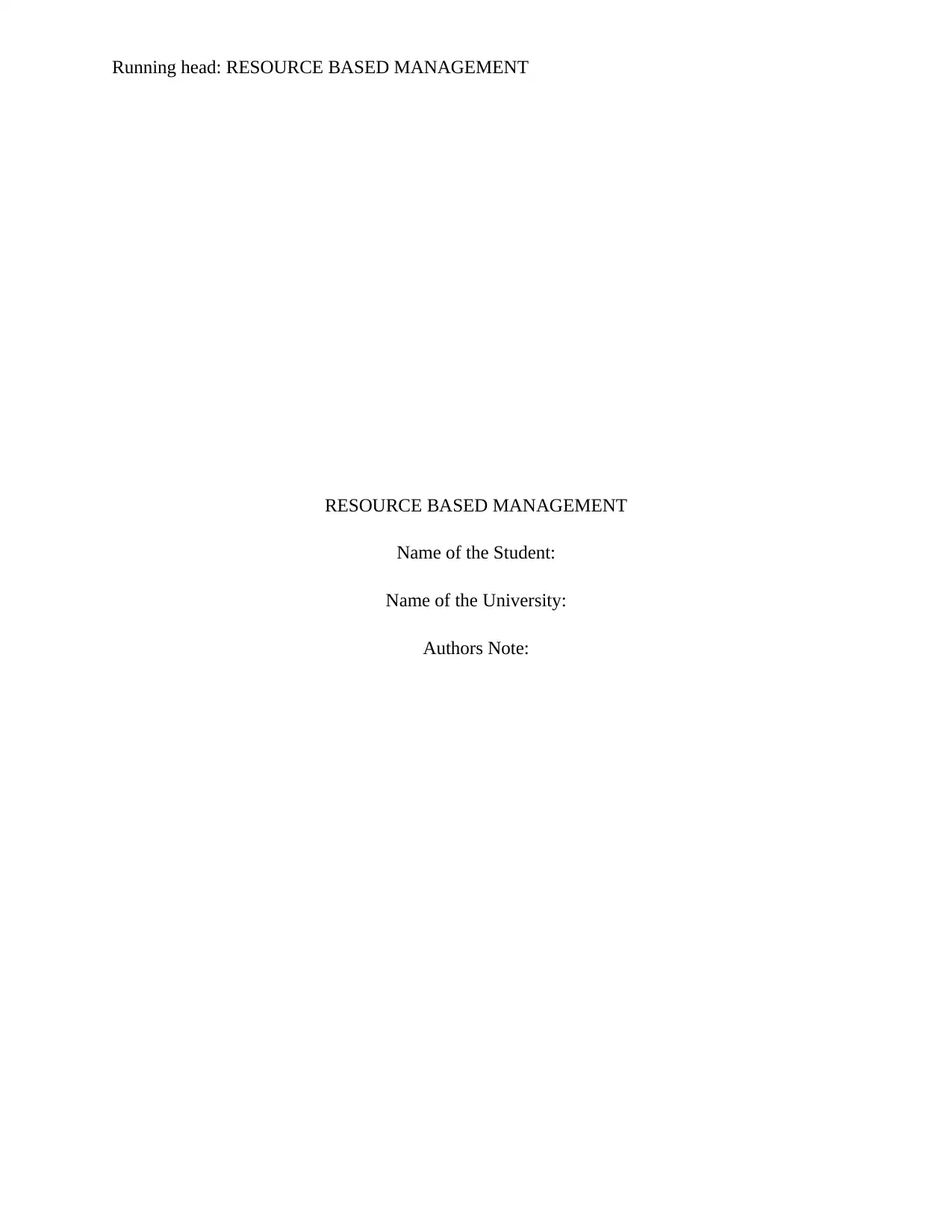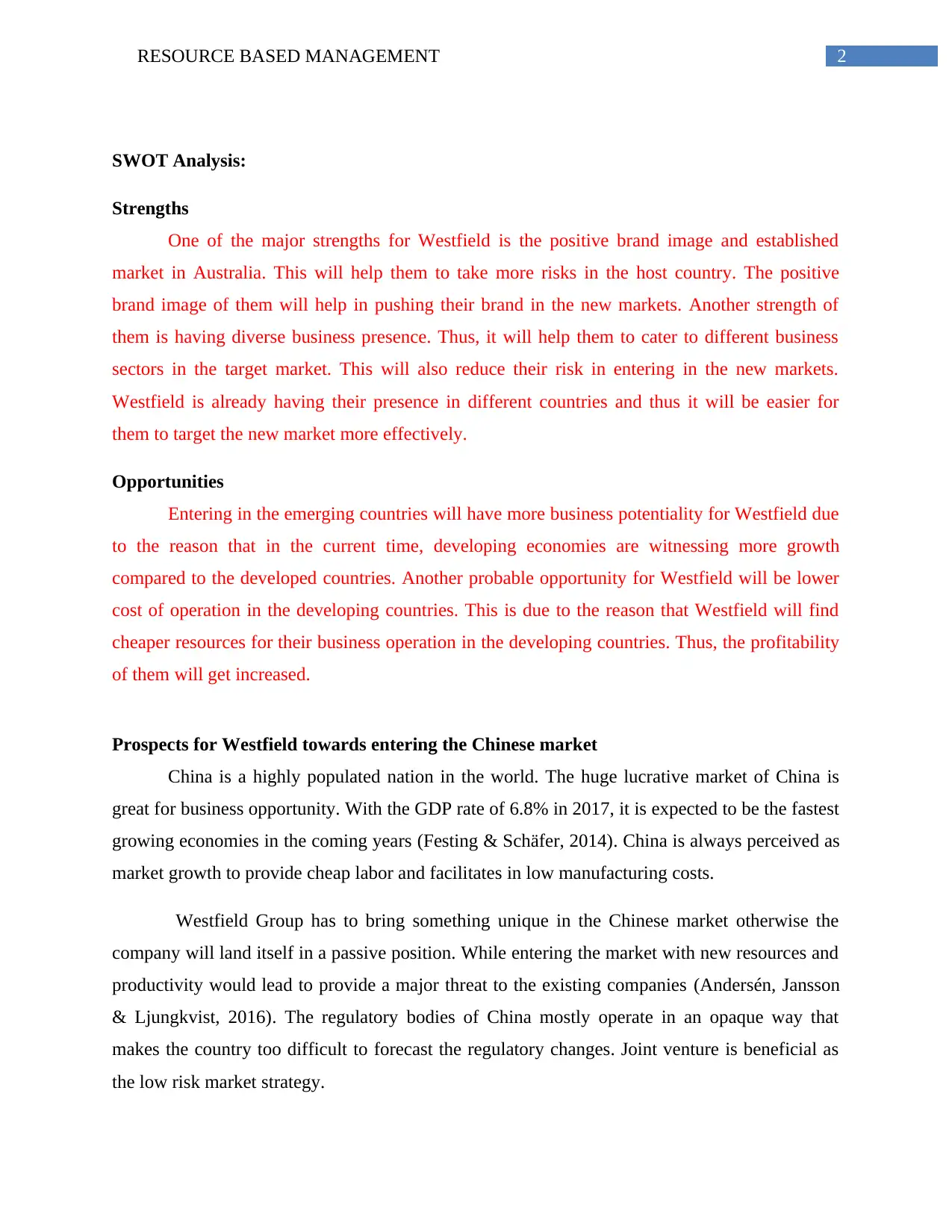Analyzing Westfield's Resources and Capabilities for China Entry
VerifiedAdded on 2023/06/13
|5
|1057
|116
Report
AI Summary
This report provides an analysis of Westfield's resources and capabilities, focusing on their potential entry into the Chinese market. It highlights Westfield's global operations, diverse product areas, and strong brand image as key capabilities. A SWOT analysis identifies strengths, weaknesses, opportunities, and threats associated with this expansion. The report emphasizes the potential of the Chinese market due to its large population and growing economy, while also acknowledging regulatory challenges. It suggests a joint venture as a beneficial low-risk market entry strategy, stressing the importance of understanding cultural differences and legal policies. The report concludes that Westfield's unique resources and capabilities, combined with a well-planned market entry strategy, are crucial for success in the Chinese market. Desklib provides access to this and other solved assignments for students.

Running head: RESOURCE BASED MANAGEMENT
RESOURCE BASED MANAGEMENT
Name of the Student:
Name of the University:
Authors Note:
RESOURCE BASED MANAGEMENT
Name of the Student:
Name of the University:
Authors Note:
Paraphrase This Document
Need a fresh take? Get an instant paraphrase of this document with our AI Paraphraser

1RESOURCE BASED MANAGEMENT
Capabilities and resources of Westfield
Capabilities of Westfield include their global operation. This is due to the reason that
according to the reports, Westfield is having their operations in Australia, New Zealand, Italy,
Croatia and the United States. Thus, they are already having the experience of entering and
operating in new countries. It will be beneficial for them to use these experiences in entering in
other foreign markets. Moreover, they are listed under the Australian stock exchange and are
publicly traded company. Thus, they are having huge access to the financial resources. Their
capabilities also include diverse product areas. According to the reports, Westfield is mainly
having their business growth in the fashion and leisure sector. Thus, these sectors will also help
them in having their market growth in the proposed host country.
Sales by sector for Westfield
Source: (www.theaustralian.com.au, 2018)
Capabilities and resources of Westfield
Capabilities of Westfield include their global operation. This is due to the reason that
according to the reports, Westfield is having their operations in Australia, New Zealand, Italy,
Croatia and the United States. Thus, they are already having the experience of entering and
operating in new countries. It will be beneficial for them to use these experiences in entering in
other foreign markets. Moreover, they are listed under the Australian stock exchange and are
publicly traded company. Thus, they are having huge access to the financial resources. Their
capabilities also include diverse product areas. According to the reports, Westfield is mainly
having their business growth in the fashion and leisure sector. Thus, these sectors will also help
them in having their market growth in the proposed host country.
Sales by sector for Westfield
Source: (www.theaustralian.com.au, 2018)

2RESOURCE BASED MANAGEMENT
SWOT Analysis:
Strengths
One of the major strengths for Westfield is the positive brand image and established
market in Australia. This will help them to take more risks in the host country. The positive
brand image of them will help in pushing their brand in the new markets. Another strength of
them is having diverse business presence. Thus, it will help them to cater to different business
sectors in the target market. This will also reduce their risk in entering in the new markets.
Westfield is already having their presence in different countries and thus it will be easier for
them to target the new market more effectively.
Opportunities
Entering in the emerging countries will have more business potentiality for Westfield due
to the reason that in the current time, developing economies are witnessing more growth
compared to the developed countries. Another probable opportunity for Westfield will be lower
cost of operation in the developing countries. This is due to the reason that Westfield will find
cheaper resources for their business operation in the developing countries. Thus, the profitability
of them will get increased.
Prospects for Westfield towards entering the Chinese market
China is a highly populated nation in the world. The huge lucrative market of China is
great for business opportunity. With the GDP rate of 6.8% in 2017, it is expected to be the fastest
growing economies in the coming years (Festing & Schäfer, 2014). China is always perceived as
market growth to provide cheap labor and facilitates in low manufacturing costs.
Westfield Group has to bring something unique in the Chinese market otherwise the
company will land itself in a passive position. While entering the market with new resources and
productivity would lead to provide a major threat to the existing companies (Andersén, Jansson
& Ljungkvist, 2016). The regulatory bodies of China mostly operate in an opaque way that
makes the country too difficult to forecast the regulatory changes. Joint venture is beneficial as
the low risk market strategy.
SWOT Analysis:
Strengths
One of the major strengths for Westfield is the positive brand image and established
market in Australia. This will help them to take more risks in the host country. The positive
brand image of them will help in pushing their brand in the new markets. Another strength of
them is having diverse business presence. Thus, it will help them to cater to different business
sectors in the target market. This will also reduce their risk in entering in the new markets.
Westfield is already having their presence in different countries and thus it will be easier for
them to target the new market more effectively.
Opportunities
Entering in the emerging countries will have more business potentiality for Westfield due
to the reason that in the current time, developing economies are witnessing more growth
compared to the developed countries. Another probable opportunity for Westfield will be lower
cost of operation in the developing countries. This is due to the reason that Westfield will find
cheaper resources for their business operation in the developing countries. Thus, the profitability
of them will get increased.
Prospects for Westfield towards entering the Chinese market
China is a highly populated nation in the world. The huge lucrative market of China is
great for business opportunity. With the GDP rate of 6.8% in 2017, it is expected to be the fastest
growing economies in the coming years (Festing & Schäfer, 2014). China is always perceived as
market growth to provide cheap labor and facilitates in low manufacturing costs.
Westfield Group has to bring something unique in the Chinese market otherwise the
company will land itself in a passive position. While entering the market with new resources and
productivity would lead to provide a major threat to the existing companies (Andersén, Jansson
& Ljungkvist, 2016). The regulatory bodies of China mostly operate in an opaque way that
makes the country too difficult to forecast the regulatory changes. Joint venture is beneficial as
the low risk market strategy.
⊘ This is a preview!⊘
Do you want full access?
Subscribe today to unlock all pages.

Trusted by 1+ million students worldwide

3RESOURCE BASED MANAGEMENT
The GDP rate of China has been growing recently since the past few years and the
growth rate is at 6.8%. (Kozlenkova, Samaha & Palmatier, 2014). The existing population of the
region also provides a great opportunity for the multinational companies to establish business.
This facilitates in providing abundant of human resources to the firm.
Westfield Group can enter the Chinese market and expand its business as the China has a
favorable business market environment. Cross border economic activities has also increased to a
great extent. The literacy rate in China has also increased and majority of the people within the
country is literate. Joint Venture will be more beneficial to do business in China (Nyberg et al.,
2014). It is the most effective way to enter in the emerging market. The cultural differences
between the two countries should be ascertained to maximize profit in the overseas target
market. Though the common business language is English still there can be language issue in the
market of China. Moreover, legislation policy also varies worldwide, hence Westfield need to
investigate the legal policies and adhered to the local laws.
The GDP rate of China has been growing recently since the past few years and the
growth rate is at 6.8%. (Kozlenkova, Samaha & Palmatier, 2014). The existing population of the
region also provides a great opportunity for the multinational companies to establish business.
This facilitates in providing abundant of human resources to the firm.
Westfield Group can enter the Chinese market and expand its business as the China has a
favorable business market environment. Cross border economic activities has also increased to a
great extent. The literacy rate in China has also increased and majority of the people within the
country is literate. Joint Venture will be more beneficial to do business in China (Nyberg et al.,
2014). It is the most effective way to enter in the emerging market. The cultural differences
between the two countries should be ascertained to maximize profit in the overseas target
market. Though the common business language is English still there can be language issue in the
market of China. Moreover, legislation policy also varies worldwide, hence Westfield need to
investigate the legal policies and adhered to the local laws.
Paraphrase This Document
Need a fresh take? Get an instant paraphrase of this document with our AI Paraphraser

4RESOURCE BASED MANAGEMENT
References:
Andersén, J., Jansson, C., &Ljungkvist, T. (2016). Resource Immobility and Sustained
Performance: A Systematic Assessment of How Immobility Has Been Considered in Empirical
Resource‐based Studies. International Journal of Management Reviews, 18(4), 371-396.
Brandon‐Jones, E., Squire, B., Autry, C. W., & Petersen, K. J. (2014). A contingent resource‐
based perspective of supply chain resilience and robustness. Journal of Supply Chain
Management, 50(3), 55-73.
Festing, M., &Schäfer, L. (2014). Generational challenges to talent management: A framework
for talent retention based on the psychological-contract perspective. Journal of World
Business, 49(2), 262-271.
Kozlenkova, I. V., Samaha, S. A., &Palmatier, R. W. (2014). Resource-based theory in
marketing. Journal of the Academy of Marketing Science, 42(1), 1-21.
Lin, Y., & Wu, L. Y. (2014). Exploring the role of dynamic capabilities in firm performance
under the resource-based view framework. Journal of business research, 67(3), 407-413.
Nyberg, A. J., Moliterno, T. P., Hale Jr, D., &Lepak, D. P. (2014). Resource-based perspectives
on unit-level human capital: A review and integration. Journal of Management, 40(1), 316-346.
www.theaustralian.com.au. (2018). Theaustralian.com.au. Retrieved 12 April 2018, from
https://www.theaustralian.com.au/business/property/westfield-corporation-to-navigate-retail-
storm/news-story/498245965eb0a4e94f61b855d718c8bb
References:
Andersén, J., Jansson, C., &Ljungkvist, T. (2016). Resource Immobility and Sustained
Performance: A Systematic Assessment of How Immobility Has Been Considered in Empirical
Resource‐based Studies. International Journal of Management Reviews, 18(4), 371-396.
Brandon‐Jones, E., Squire, B., Autry, C. W., & Petersen, K. J. (2014). A contingent resource‐
based perspective of supply chain resilience and robustness. Journal of Supply Chain
Management, 50(3), 55-73.
Festing, M., &Schäfer, L. (2014). Generational challenges to talent management: A framework
for talent retention based on the psychological-contract perspective. Journal of World
Business, 49(2), 262-271.
Kozlenkova, I. V., Samaha, S. A., &Palmatier, R. W. (2014). Resource-based theory in
marketing. Journal of the Academy of Marketing Science, 42(1), 1-21.
Lin, Y., & Wu, L. Y. (2014). Exploring the role of dynamic capabilities in firm performance
under the resource-based view framework. Journal of business research, 67(3), 407-413.
Nyberg, A. J., Moliterno, T. P., Hale Jr, D., &Lepak, D. P. (2014). Resource-based perspectives
on unit-level human capital: A review and integration. Journal of Management, 40(1), 316-346.
www.theaustralian.com.au. (2018). Theaustralian.com.au. Retrieved 12 April 2018, from
https://www.theaustralian.com.au/business/property/westfield-corporation-to-navigate-retail-
storm/news-story/498245965eb0a4e94f61b855d718c8bb
1 out of 5
Related Documents
Your All-in-One AI-Powered Toolkit for Academic Success.
+13062052269
info@desklib.com
Available 24*7 on WhatsApp / Email
![[object Object]](/_next/static/media/star-bottom.7253800d.svg)
Unlock your academic potential
Copyright © 2020–2025 A2Z Services. All Rights Reserved. Developed and managed by ZUCOL.





